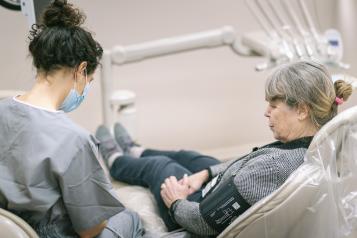Flexibility and communication would improve local Orthodontic care

In our NHS Orthodontic Care Report, 57 per cent of participants said their child had faced difficulties accessing services, with some waiting up to two years from referral to starting treatment. Other concerns raised in the Report included appointment timing, communication and information problems, poor continuity of care and accessibility.
Orthodontics is the care and treatment provided, usually to children, to straighten their teeth and/or correct how their upper and lower teeth meet and work together. Orthodontics correct existing teeth, jaw irregularities and prevent problems that may occur later in life.
Patients are referred and assessed based on clinical need and only those who meet certain thresholds are eligible to receive NHS orthodontic treatment. This is free for those under 18 who need treatment for their future health.
Why did we do this research?
Healthwatch Hertfordshire was commissioned by the NHS Hertfordshire and West Essex Integrated Care Board (ICB) to gather feedback about local orthodontic services. The aim was to hear from children/young people, parents and carers who had accessed NHS orthodontic care within the last 2 years.
We engaged with people through an online survey, alongside in-depth interviews with parents/carers, children and young people between March and May 2024. We heard from 60 people through the survey and 10 parents/young people through the interviews.
What did people tell us?
-
Long waiting times – this is a key issue, alongside lack of communication and information, which means some people are not only waiting months or years, in some cases they don’t even know if they have been referred by their dentist.
"We had a year’s wait just to be assessed and to confirm if eligible for NHS braces. To then be told we have at least another year to 18 months to wait to potentially start treatment.”
-
Limited appointment availability - many people had difficulty with appointments only available during school and working hours. Parents and carers also said missing school was a concern because at that age, many young people were sitting GCSE and A-Level exams.
“By the time I’ve driven them to school, done the wait, come back, dropped them back at school and then I’ve got back to my work, that’s a 2-hour turnaround.”
-
Poor communication and information – a range of concerns were highlighted including lack of explanation about conditions, treatment options, waiting times and ongoing care. Some felt continuity of care was lacking, due to a disconnect between the dentist and orthodontist.
“After they put the braces on I feel like maybe they could have explained a bit better how to look after It because it was just a one minute conversation. They gave me the cleaning kit but it had no instructions, there was no piece of paper or anything.”
-
Lack of treatment choice - some said they were not consulted about whether the orthodontic treatment was necessary or offered any alternatives. Many also said they didn’t know they could choose an orthodontic practice.
“It feels like it’s a well-oiled machine that’s pushing through a thousand teenagers to the end point, which is to put braces on so everyone has perfect teeth, but I’m not quite sure we all need that.”
-
Disappointing quality of care - a few people felt the care their child received was “rushed” and impersonal. Others were also concerned about not being allowed into the appointment (due to space) and not having proper information conveyed afterward.
“As my son is an older teenager he was briefed about caring for his new braces without me being present. He wasn’t prepared with any questions to ask and didn’t remember the information he was given.”
-
Poor accessibility provision – some told us their orthodontic practice did not know how to support patients with additional needs, such as autism or disabilities.
“My son is in a wheelchair and it is very difficult to access the orthodontist from the parking to physically entering the building and getting him in the chair. They had no way of taking X-Rays.”
What happens next?
Our findings highlighted a range of improvements that could be made to NHS orthodontic care. We have recommended:
- Improving communication from orthodontic practices to ensure individuals are adequately informed about their treatment and options.
- Improving transparency around expected waiting times from the point of referral to starting treatment.
- Improving the continuity of care between dentists and orthodontists to reduce the number of patients whose referrals are forgotten or lost.
- Increasing appointment availability and flexibility to make it easier for individuals to attend their appointments.


